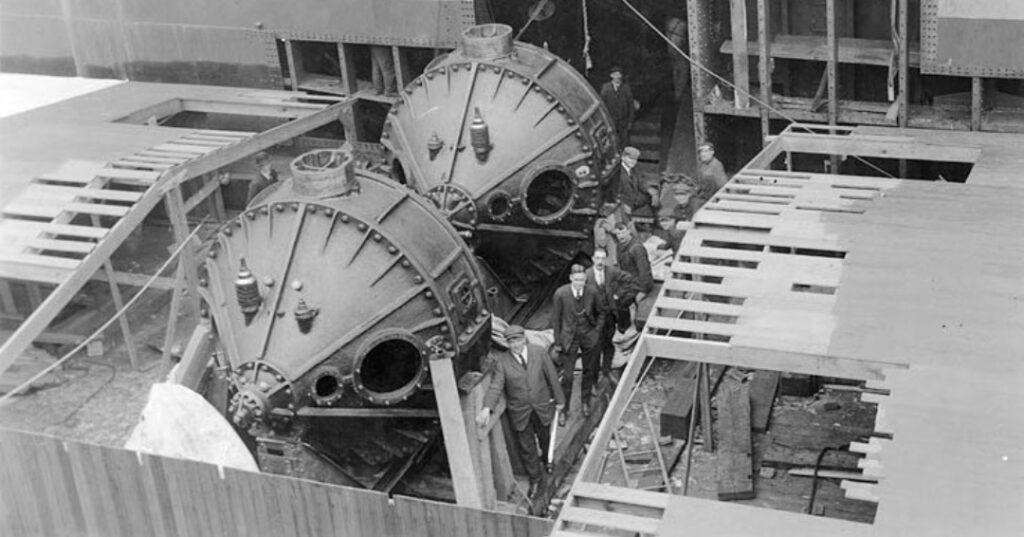While many people tend to associate marine gyro stabilization with cutting-edge technology and recent advancements, the history of these remarkable machines runs far deeper. The origin of this technology reaches back into the early 20th century, revealing a legacy that predates modern innovations.

THE PIONEERING ERA: THE RISE AND FALL OF EARLY GYRO STABILIZERS
Taking a leap back in time, marine stabilization technology had modest beginnings. Transport yourself to a bygone era, and step aboard a vessel in the early 20th century, where the foundations of marine stabilization technology were just taking shape. Picture the late 1860s, a time when daring experiments with gyroscopes were initiated, a trend that persisted into the early 1900s.
Now, fast forward to the year 1917, during the throes of World War I, and imagine the USS Henderson, a pioneering example of naval innovation. This colossal transport vessel introduced a groundbreaking concept to the world of ship design: gyro stabilizers. As you wander the decks of the USS Henderson, you’d notice two massive 25-ton flywheels, each boasting an impressive 9-foot (2,7 m) diameter. These colossal flywheels were strategically positioned near the ship’s central core and were tirelessly spun at an astounding 1100 RPM by robust 75 HP AC motors.
In the early days, these gyro stabilizers, while revolutionary, had limitations due to their size, weight, and power consumption. They were primarily restricted to ships with ample space and generating capacity. Consequently, by the mid-1900s, active fins had taken over as the dominant method of stabilizing ships and small vessels.
Progressing forward into the early 20th century, ships predominantly depended on passive mechanisms such as bilge keels and paravanes. Bilge keels, which were fins affixed to the sides of the hull, aimed to diminish rolling, while paravanes were towed devices employed to stabilize a ship’s movement. These passive methods offered stability and comfort but were a far cry from the technological innovations we enjoy today.
RECENT DEVELOPMENTS AND DIGITAL ADVANCEMENTS
The resurgence of gyroscopic vessel stabilizers in the marine market didn’t become a serious option until the early 2000s when Mitsubishi introduced its Anti-Roll Gyro. This marked a significant turning point in the industry, rekindling interest in this technology. Other companies soon followed suit, recognizing the potential of developing user-friendly gyro stabilizers for the recreational market.
Originally designed to counter the age-old problem of nausea, leading to full-on motion sickness, stabilizer systems often claim a number of secondary benefits. As technology continued to advance, marine stabilization systems evolved further with the integration of digital control systems. These smart systems allowed for precise and real-time adjustments to the stabilizers, making them adaptable to changing sea conditions. With digital control, vessels can navigate through rough waters more comfortably and safely, with crews and boat owners alike more in control than ever before.
SMARTGYRO’S PIONEERING ROLE
In line with others in earlier years, Smartgyro has astutely recognized the vast potential for growth and innovation in the gyro stabilizer market. Their innovative products stand as a testament to the continued evolution of the industry, pushing the boundaries of what is possible in marine stabilization.
Their wide range of gyroscopic stabilizers are designed to provide efficient and effective stabilization for an extensive variety of vessels, from smaller yachts to large cruisers, Smartgyro assures that boats of all size have the opportunity to “Feel the Magic”.
One of the standout features of Smartgyro’s systems is their modular mechanical design. This unique feature allows for seamless retrofitting onto existing vessels and effortless integration into new designs. Furthermore, this modularity simplifies maintenance procedures, enhancing user experience.
FUTURE HORIZONS FOR MARINE STABILIZATION TECHNOLOGY
The future of marine stabilization technology looks promising. As the world continues to prioritize sustainability, we can expect further innovations in this field. Additionally, we may see developments in predictive analytics, AI-assisted stabilization, and even autonomous vessels that rely on advanced stabilization technology to ensure smooth and safe voyages. These innovations in marine stabilization technology are not only about safety, operational efficiency, and the reduction of environmental impact but also, underscores that a smoother voyage isn’t a mere luxury – but a necessity and something boat owners have historically struggled to overcome.




